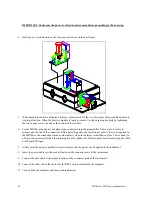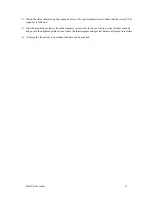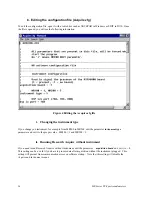
Start-Up Procedure
23
Some notes are given here involving relative humidity as this term can be confusing as it represents only a
relative measurement of water and not an absolute one, and, so, will vary with conditions encountered.
The relative humidity with respect to water is defined as being the ratio of the amount of water that the air
actually holds to the amount of water that the air can possibly hold [or in technical terms; the ratio of the actual
mixing ratio (W
a
) to the saturation mixing ratio (W
s
)], expressed as a percentage:
RH(%) = W
a
/ W
s
* 100
As air is heated its ability to hold more water increases (saturation level increases), while conversely, as air is
cooled its ability to hold water is decreased (saturation level decreases.) In figure I-3, a plot showing the
saturation concentration for water in air (over water) at various temperatures is given. For example, the
saturation concentration at 30
o
C will be approximately 4% by volume (at standard atmospheric pressure.)
Therefore, at 30
o
C and 40% relative humidity, the actual concentration of water in the air will be near 1.6% by
volume. When the actual mixing ratio and saturation mixing ratio become equal, the dew point is reached and
condensation may occur. This is a common occurrence at night when the temperature of objects cools below the
temperature of the air resulting in a dew forming on car windows, plants, and so forth. With this in mind, when
the relative humidity is requested to be below a certain level, it is important to note this temperature dependency,
and is the reason why the optical materials are requested to remain above ambient temperature levels to ensure
that the material remain above the dew point.
0
10
20
30
Saturation concentration over water
Temperature (degrees Celcius)
6
5
4
3
2
1
0
Figure 5-3. Saturation water levels with temperature.
(Taken from Smithsonian tables.)
This is especially important when materials may be brought from one environment to another where the two are
of different temperatures. To move from a warm environment to a cooler environment will not pose a problem,
for condensation onto the material, as the dew point of the material will naturally be higher than for the cooler
temperature environment. However, in moving from a cooler environment to a warmer environment, the optical
materials may already be below the dew point temperature and will be susceptible to condensation to occur onto
the surface of the material. As an example, assume that some materials were taken from outside to an inside
location where the temperatures are 15
o
and 25
o
C, respectively. If the relative humidity for each environment is
35%, then the result of bringing the materials inside would be to expose the material to an
effective relative


































